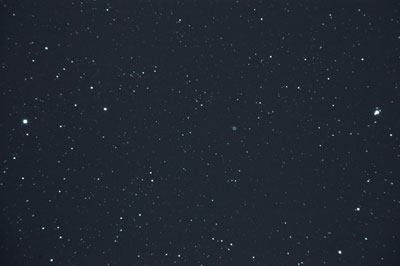Lyra with the bright main star Vega is a small but distinctive constellation. The deep-sky objects in Lyra are mainly interesting for telescope owners, but it also contains some bright stars for the naked eye.
α Lyrae (Vega) is only 25 light-years away. It is a very young star and still surrounded by a disk of dust, from which perhaps a planetary system may form. With 0.03m Vega is the fifth-brightest star in the sky. 12,000 years ago, the northern celestial pole lay in the vicinity of Vega – because of the wobbling of Earth‘s axis (the precession) it is now in the direct vicinity of the present-day polar star in the Little Dipper. Vega was the first star that was photographed: The first astro-photograph was taken the night of 16th or 17th of July, 1850 at Harvard Observatory. The image was exposed for 100 seconds through a 15-inch telescope.
β Lyrae (Sheliak) is one of the stars that are best explored. In binoculars you can clearly see two stars, separated 46 arc seconds from each other. The darker star is at a constant 6.7m, while the brighter star is one of the most remarkable eclipsing binaries. Within 12.94 days its brightness decreases twice from 3.3m to 3.8m and 4.1m. You can see the light change very well if you compare it to the 3.3m bright γ Lyrae. β¹ consists of two stars with fifteen and nineteen times the solar diameter, which are separated only by 22 million miles (35 million kilometers). Thus, the atmospheres of the two stars, which are distorted to an elliptical shape, overlap. Moreover, they mutually exchange matter, which slows the period. The light curve appears rounded by the deformation of the stars.
Four other stars also belong to the 880 light-years away β Lyrae system, but they remain invisible in binoculars and require a telescope.
δ Lyrae is an optical double star. The main star is a 5.6m bluish-white star at a distance of 1,080 light-years. 10.5 arc minutes away from it you can find a red giant with a distance of 900 light-years. This red giant changes its brightness regularly from 4.5 and 6.5m. The color contrast between the two stars is striking. A look at the surrounding area is also worth it. The star pair marks the open cluster Stephenson 1, which is also referred to as δ Lyrae group. The 1,000 light-years distant star cluster has a diameter of about 20 arc minutes, which corresponds to six light-years. It is 50 million years old, about as old as the Pleiades, and offers a pretty sight especially in larger binoculars.
ε Lyrae is a popular object at every star party to demonstrate the resolution capability of smaller telescopes. ε ¹ and ε² stand 208 arcsec apart, which corresponds approximately to the resolution limit of the naked eye. ε¹ is the more northerly of the two stars that shine approximately at the same brightness – 5.0 and 5.2m. ε Lyrae is 160 light-years away, so the two stars are separated by 0.2 light-years from each other.
In a telescope with at least 100x magnification, you can see that each of the two stars has a close companion. As „Double Double“, this quadruple star is one of the most well-known multiple stars and is often used as a test object for small telescopes. The brightest star might even be a spectroscopic binary, but this is not for sure yet.
ζ Lyrae is a physical double star, whose components are 44 seconds of arc apart. It can easily be separated with 7x magnification. ζ Lyrae is 155 light-years away, the two individual stars are 4.4 and 5.6m bright.

The most famous object in this constellation is M 57, the Ring Nebula. It can be seen in binoculars at best as an unobtrusive, 9.0m bright star. At 15x magnification it appears a bit fuzzy (see the illustration in the chapter Stars and Deep-Sky-Objects). Although it is one of the most beautiful planetary nebulae, which can be observed through the telescope, it remains at best a difficult object even in large binoculars – only a telescope can deliver the necessary magnification. The 1,800 light-years distant stellar corpse is only about one minute of arc in size and slightly southward from the line of β and γ Lyrae. The real diameter of M 57 is half a light-year, the nebula extends with about 11 miles per second (18 km/s). It was created about 20,000 years ago.
The five minutes of arc large globular cluster M 56 is slightly easier to see than M 57 and appears as 8.3m bright, structure less patch of light. It is located about halfway between β Cygni (Albireo) and γ Lyrae in a star-rich region. 32,000 light-years separate us from it.
